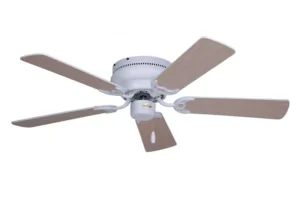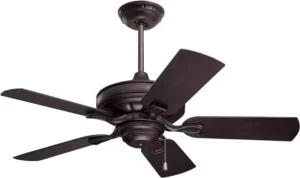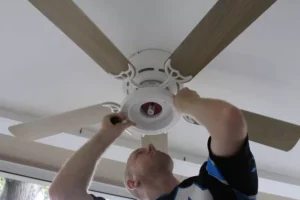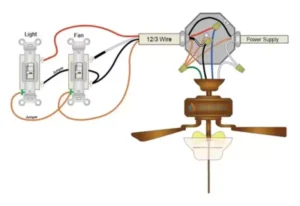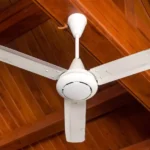Can a Ceiling Fan Make a Room Warmer?
A typical fixture in many houses, ceiling fans offer an economical and energy-efficient means of cooling a space during hot weather. Some people do wonder, though, if these fans might help warm a space as the temperature drops. This post will discuss ceiling fan dynamics, how they affect room temperature, and other elements that go into creating a warm and inviting space.
The Role of Ceiling Fans in Heat Distribution
Ceiling fans are primarily designed for air circulation, and their function is to create a breeze that helps in cooling the room by promoting evaporation from the skin’s surface. But can they be used to distribute heat effectively as well? Let’s delve into the details.
1. Fan Direction Matters: Clockwise for Winter
Ceiling fans typically have a switch that allows you to change the direction of the blades. During winter, setting the fan to rotate in a clockwise direction is key. This gentle updraft helps in distributing warm air that naturally rises to the ceiling. By doing so, the fan assists in preventing heat stratification, a common issue where the lower portion of the room stays cool while the upper part retains warmth.
2. Room Size and Ceiling Height Considerations
The size of the space and the height of the ceiling determine how well a ceiling fan distributes heat. A fan may need to run faster in larger rooms in order to maintain enough air circulation. Furthermore, to get the most out of fans in rooms with higher ceilings, it might be necessary to get fans made especially for those kinds of areas.
3. Insulation Plays a Vital Role
The level of insulation in your home significantly influences how well a ceiling fan can contribute to warming a room. Proper insulation helps in retaining heat, allowing the fan to circulate warm air more efficiently. In contrast, poorly insulated rooms may experience a quicker loss of heat, making it challenging for the fan to make a noticeable difference.
Factors Affecting Perceived Temperature
Beyond the technical aspects of ceiling fan operation, several factors contribute to how we perceive the warmth of a room. Understanding these elements can help in maximizing the comfort level without solely relying on adjusting the thermostat.
1. Personal Heating vs. Raising Temperature
Ceiling fans, when used in winter, are not designed to raise the overall temperature of a room but rather to make individuals in the room feel warmer. This is achieved through the distribution of existing warm air, providing a localized sense of comfort without affecting the thermostat setting.
2. Air Movement Effect and Draft Sensation
The movement of air created by a ceiling fan can influence the perception of temperature. Even if the room temperature remains the same, the perceived temperature may increase due to the air movement, creating a draft sensation. Adjusting the fan speed and direction can help strike a balance between air circulation and comfort.
3. Negligible Heat Generation
It’s crucial to note that ceiling fans themselves do not generate heat. Unlike traditional heaters or radiators, they rely on the redistribution of existing air. While this makes them energy-efficient, it also means that their impact is limited to improving the perception of warmth rather than actively contributing to heating the room.
Energy Efficiency and Cost-Effectiveness
Ceiling fans offer a practical and cost-effective alternative to traditional heating methods. Let’s explore the energy efficiency and cost-effectiveness of using ceiling fans for winter heating.
1. Energy Efficiency Comparison
Ceiling fans often use less energy than room heaters or central heating systems. They can run at lower temperatures and use less electricity, which lowers energy consumption overall. They are therefore a green choice for people trying to reduce their environmental impact.
2. Seasonal Usage and Cost Savings
Ceiling fans are versatile appliances that can be used year-round. In winter, when heating needs are higher, using fans strategically can help in maintaining a comfortable environment without a significant increase in energy costs. This dual-purpose functionality adds to their cost-effectiveness, providing value for money throughout the year.
Conclusion: Achieving Thermal Comfort with Ceiling Fans
In summary, while ceiling fans themselves do not generate heat, they can contribute to making a room feel warmer by improving heat distribution and promoting air circulation. To maximize their effectiveness, consider factors such as fan direction, room size, ceiling height, and insulation. Additionally, understand that the impact of ceiling fans on temperature is more about personal comfort and perceived warmth rather than actively raising the room’s temperature.
By strategically using ceiling fans during winter, you can enhance your home’s comfort level, reduce energy consumption, and enjoy a cozy living space without solely relying on traditional heating methods. So, the next time you wonder if a ceiling fan can make a room warmer, the answer lies in understanding and optimizing its role in promoting thermal comfort.





